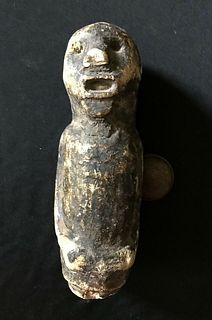Olmec Jadeite Face or Mask Amulet
Lot 96a
About Seller
Artemis Fine Arts
686 S Taylor Ave, Ste 106
Louisville, CO 80027
United States
Selling antiquities, ancient and ethnographic art online since 1993, Artemis Gallery specializes in Classical Antiquities (Egyptian, Greek, Roman, Near Eastern), Asian, Pre-Columbian, African / Tribal / Oceanographic art. Our extensive inventory includes pottery, stone, metal, wood, glass and textil...Read more
Estimate:
$1,500 - $2,000
Absentee vs Live bid
Two ways to bid:
- Leave a max absentee bid and the platform will bid on your behalf up to your maximum bid during the live auction.
- Bid live during the auction and your bids will be submitted real-time to the auctioneer.
Bid Increments
| Price | Bid Increment |
|---|---|
| $0 | $25 |
| $300 | $50 |
| $1,000 | $100 |
| $2,000 | $250 |
| $5,000 | $500 |
| $10,000 | $1,000 |
| $20,000 | $2,500 |
| $50,000 | $5,000 |
| $100,000 | $10,000 |
| $200,000 | $20,000 |
About Auction
By Artemis Fine Arts
Dec 3, 2020
Set Reminder
2020-12-03 10:00:00
2020-12-03 10:00:00
America/New_York
Bidsquare
Bidsquare : Fine Antiquities, Ethnographic & Fine Art
https://www.bidsquare.com/auctions/artemis-gallery/fine-antiquities-ethnographic-fine-art-6119
Features classical antiquities, ancient and ethnographic art from cultures encompassing the globe. Egyptian, Greek, Roman, Etruscan, Near Eastern, Asian, Pre-Columbian, Native American, African / Tribal, Oceanic, Spanish Colonial, Russian, Fine Art, so much more! All legally acquired, legal to sell. Artemis Fine Arts info@artemisfinearts.com
Features classical antiquities, ancient and ethnographic art from cultures encompassing the globe. Egyptian, Greek, Roman, Etruscan, Near Eastern, Asian, Pre-Columbian, Native American, African / Tribal, Oceanic, Spanish Colonial, Russian, Fine Art, so much more! All legally acquired, legal to sell. Artemis Fine Arts info@artemisfinearts.com
- Lot Description
Pre-Columbian, Southern Mexico to Guatemala, Olmec, ca. 1200 to 900 BCE. A finely carved, jadeite amulet of a face or maskette in square form with a recessed back and a pair of horizontal drill holes, one in each upper corner, for suspension. Topped with a helmet decoratively incised into 3 sections with 2 side flaps protecting his ears, the grievous visage features a furrowed brow, a pair of closed almond-shaped eyes, a broad nasal ridge, a flat nose with incised nostrils, a clearly delineated medial cleft, and a full-lipped frown. Boasting a lustrous burnish, the amulet's smooth surface is naturally adorned in mottled hues of celadon, olive, russet, and sea green with black and viridian striations. Size: 1.75" L x 1.125" W x 1.75" H (4.4 cm x 2.9 cm x 4.4 cm)
We know that the Olmec settled in areas including San Lorenzo Tenochtitlan, La Venta, Tres Zapotes, Laguna de los Cerros, and La Mojarra; however, their influence impacted the entire Mesoamerican region. In 2005, Neutron Activation Analysis and petrography was used to demonstrate this impact via the widespread existence of Olmec ceramic vessels. Scholars suspect that other groups equated the Olmec style with elite status given the exchange and emulation of Olmec artifacts throughout Mesoamerica. It is also believed that the Olmec invented the famous Mesoamerican ballgame prevalent among the later Maya as well as other cultures in the region, and may have also invented religious entities such as the feathered serpent and the rain god, which would continue in subsequent cultures.
While difficult to completely understand their belief system, given that the Olmec were pre-literate, scholars theorize that their famous monumental stone heads, which can weigh up to forty tons, may have been erected to honor ancestors or rulers. The smaller jade and greenstone figures and amulets like this example are thought to represent totems or divinities. The artistry and technique of Olmec sculptural works is remarkable given what little technology was available to them as well as the dearth of earlier works to reference for inspiration. The Olmec style oftentimes embraces a certain amount of naturalism as well as abstract interpretation of particular features as we see in this example.
Please note that the Lucite stand is for photography purposes only.
Provenance: private Los Angeles County, California, USA collection, acquired between 1950-1990
All items legal to buy/sell under U.S. Statute covering cultural patrimony Code 2600, CHAPTER 14, and are guaranteed to be as described or your money back.
A Certificate of Authenticity will accompany all winning bids.
We ship worldwide and handle all shipping in-house for your convenience.
#135817Collection label on back. Repaired from 6 to 8 pieces with break lines visible. Minor chips to proper upper right front side and upper left back side. Expected light softening of details commensurate with age. Otherwise, very nice with lovely earthen deposits in recessed areas.Condition
- Shipping Info
-
All shipping is handled in-house for your convenience. Your invoice from Artemis Gallery will include shipping calculation instructions. If in doubt, please inquire BEFORE bidding for estimated shipping costs for individual items.
-
- Buyer's Premium



 EUR
EUR CAD
CAD AUD
AUD GBP
GBP MXN
MXN HKD
HKD CNY
CNY MYR
MYR SEK
SEK SGD
SGD CHF
CHF THB
THB














